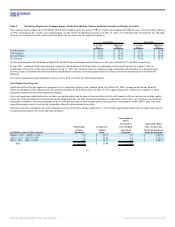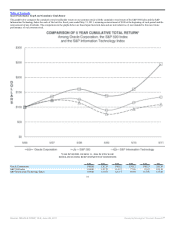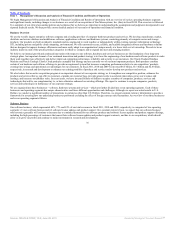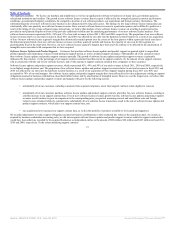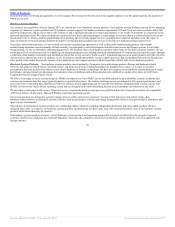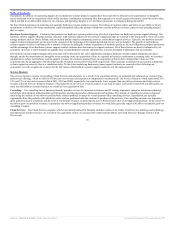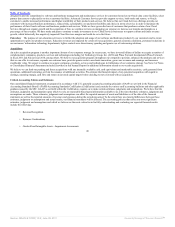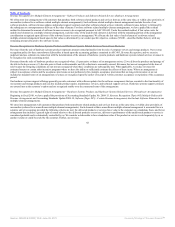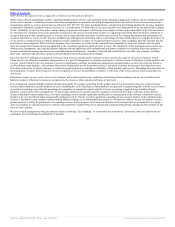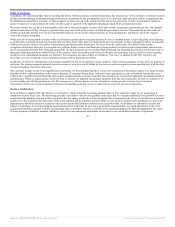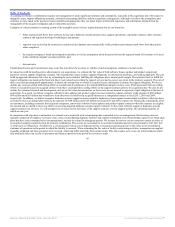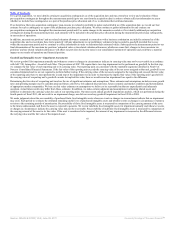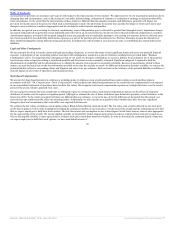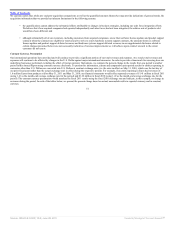Oracle 2010 Annual Report Download - page 45
Download and view the complete annual report
Please find page 45 of the 2010 Oracle annual report below. You can navigate through the pages in the report by either clicking on the pages listed below, or by using the keyword search tool below to find specific information within the annual report.
Table of Contents
• Accounting for Income Taxes
• Legal and Other Contingencies
• Stock-Based Compensation
• Allowances for Doubtful Accounts
In many cases, the accounting treatment of a particular transaction is specifically dictated by GAAP and does not require management’s judgment in its
application. There are also areas in which management’s judgment in selecting among available alternatives would not produce a materially different result. Our
senior management has reviewed the below critical accounting policies and related disclosures with the Finance and Audit Committee of the Board of Directors.
Revenue Recognition
Our sources of revenues include: (1) software, which includes new software license revenues and software license updates and product support revenues;
(2) hardware systems, which includes the sale of hardware systems products including computer servers and storage products, and hardware systems support
revenues; and (3) services, which include software and hardware related services including consulting, Cloud Services and education revenues.
Revenue Recognition for Software Products and Software Related Services (Software Elements)
New software license revenues represent fees earned from granting customers licenses to use our database, middleware and applications software, and exclude
revenues derived from software license updates, which are included in software license updates and product support revenues. While the basis for software
license revenue recognition is substantially governed by the accounting guidance contained in ASC 985-605, Software-Revenue Recognition, we exercise
judgment and use estimates in connection with the determination of the amount of software and services revenues to be recognized in each accounting period.
For software license arrangements that do not require significant modification or customization of the underlying software, we recognize new software license
revenues when: (1) we enter into a legally binding arrangement with a customer for the license of software; (2) we deliver the products; (3) the sale price is fixed
or determinable and free of contingencies or significant uncertainties; and (4) collection is probable. Revenues that are not recognized at the time of sale because
the foregoing conditions are not met are recognized when those conditions are subsequently met.
Substantially all of our software license arrangements do not include acceptance provisions. However, if acceptance provisions exist as part of public policy, for
example, in agreements with government entities where acceptance periods are required by law, or within previously executed terms and conditions that are
referenced in the current agreement and are short-term in nature, we generally recognize revenues upon delivery provided the acceptance terms are perfunctory
and all other revenue recognition criteria have been met. If acceptance provisions are not perfunctory (for example, acceptance provisions that are long-term in
nature or are not included as standard terms of an arrangement), revenues are recognized upon the earlier of receipt of written customer acceptance or expiration
of the acceptance period.
The vast majority of our software license arrangements include software license updates and product support contracts, which are entered into at the customer’s
option and are recognized ratably over the term of the arrangement, typically one year. Software license updates provide customers with rights to unspecified
software product upgrades, maintenance releases and patches released during the term of the support period. Product support includes internet access to technical
content, as well as internet and telephone access to technical support personnel. Software license updates and product support contracts are generally priced as a
percentage of the net new software license fees. Substantially all of our customers renew their software license updates and product support contracts annually.
41
Source: ORACLE CORP, 10-K, June 28, 2011 Powered by Morningstar® Document Research℠




